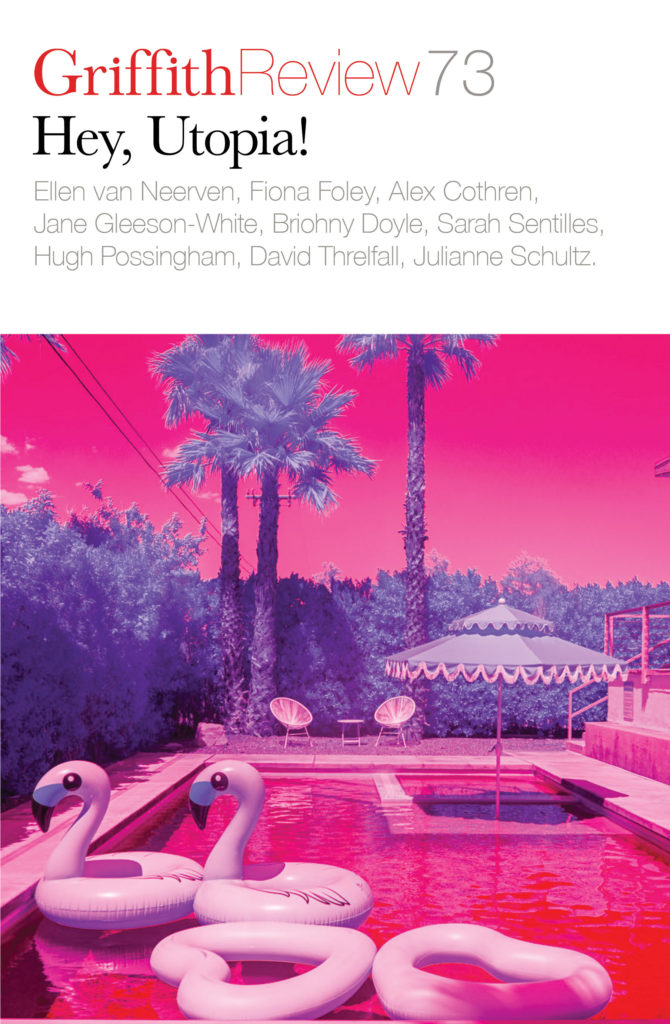Featured in

- Published 20210803
- ISBN: 978-1-922212-62-7
- Extent: 264pp
- Paperback (234 x 153mm), eBook

IN 2013 GRIFFITH Review published an issue focused on Tasmania, which I co-edited with founding editor Julianne Schultz. We sensed that a big wave of attention was about to break in relation to Australia’s smallest and most southerly state. My own curiosity around this was grounded in my role as founding director of the Inglis Clark Centre at the University of Tasmania, established to enhance public dialogue and build engagement across sectors in Tasmania’s interest.
I was keen to advance the neglected legacy of nineteenth-century Tasmanian jurist Andrew Inglis Clark. Born in Hobart in 1848 to Scottish immigrants, just up the road from where I’m writing this, Clark built an eclectic career based on the pursuit of justice, and especially enjoyed challenging discussion. He was a modernising parliamentarian, one of the drafters of the Australian Constitution, an advocate of Tasmania’s quirky Hare-Clark electoral system that is grounded in proportional representation, and attracted to the ideals of American and Italian republicanism. Clark was unusually good for his time on gender, supporting universal suffrage. He was more questionable on race – and not unusual for his time. Despite objecting to slavery, not least because of the influence of American political lessons on his thinking, Clark supported what we now call White Australia in relation to restricting Chinese immigration. His views on the way Aboriginal Tasmanians had been treated since British colonisation haven’t yet received much attention.
As we curated contributions for Tasmania – The Tipping Point? I was both intrigued and irritated by recurring fantasies of Tasmania as some kind of utopia. That label’s famously a throwback to a sixteenth-century work by English lawyer and humanist Sir Thomas More, now a Catholic saint. More wrote about a fictional island society in the oceans of the southern hemisphere, whose members were dedicated to striving towards a kind of social perfection. Obviously, nowhere is anything like perfect – including Tasmania. But Tasmania assuredly is an island plonked in the middle of oceans way down south. Which may be why utopian projections keep landing on our strip – as though we’re a kind of blank screen or terra nullius. My favourite’s probably the 1930s campaign driven by a well-heeled Melburnian gentile called Critchley Parker to establish a safe haven in the wilderness in south-west Tasmania for European Jews fleeing Nazi Germany. Parker’s grand design included establishing a French-inspired fashion industry, drawing on the skills of immigrants with proven sector know-how.
Tasmania – The Tipping Point? fast became a bestseller. It was widely credited with changing the national conversation about the economic, social and cultural challenges and opportunities that are specific to my home state. In recent years, a range of incomers and influencers have asked for an updated version, but I felt there wasn’t much more to say. Confined back in Tasmania since the outbreak of the COVID-19 pandemic last March – when The Mercury newspaper emblazoned WE’VE GOT A MOAT AND WE’RE NOT AFRAID TO USE IT on its front page, as the premier physically closed Tasmania off to wipe out a cluster of local infections – I’ve now reconsidered.
SO MANY PEOPLE have lost all kinds of perspective through this pandemic, many Tasmanians included. Our tough COVID-19 border closure made for a tougher winter here, as almost every Tasmanian-based business whose viability depended on an open island stared down the barrel of wipe-out. As the weeks and months rolled on, it became increasingly difficult to talk cogent strategy with anyone on the public payroll – still a disproportionately large percentage of working Tasmanians, despite recurring promises for more contemporary public sector governance and service delivery. Like all of us, these professionals were authentically anxious when COVID-19 exploded, but they had zero financial skin in this brand new game that was fast cutting to the bone. I won’t recount some of the off-record conversations I had at the time, but some helped decent people straddling that split to hold things together at key choke points. Others left me swearing to myself in unprecedented frustration. Meanwhile, the moat mentality was fuelling a parochial boosterism that spread like another kind of virus across the island. Nowhere in the world like Tassie! Awesome we’ve got Tassie back for ourselves!! Especially from the f*cking Chinese!!!! Paraphrasing the Vicky Pollard character in the recently maligned Little Britain television series broadcast by the BBC in the early 2000s, my response to all that is yeah but no but yeah but…NO. Like all remote communities with a limited local gene pool of talent and experience, Tasmania always works at its best in a situation of wider, smarter, more diverse and edgier exchange.
Tasmania undoubtedly is blessed to have been protected from the global ravages of COVID-19 by our mix of physical isolation, low population density and that well-timed border closure. Tasmanians still haven’t been forced behind face masks anywhere except our airports, which reopened for non-essential travel in December 2020. We’ve barely practised social distancing – riffing off Tasmania’s substandard literacy skills base, a wicked friend quips that’s because half of us can’t read the signs and even fewer can count to 1.5 metres. Astonishingly, only 234 Tasmanians have contracted COVID-19 and just thirteen have died of it. I can’t sneer at our sweetly safe fortune here, in part because so many people outside Australia – where COVID-19 has truly raged – might metaphorically kill for a slice of it right now. And there’s never been any doubting the stunning natural beauty of many Tasmanian landscapes. Throw in social media snaps from dedicated chasers of aurora australis, bioluminescence like sparkling blue diamonds in the night sea, and the elusive but photogenic inland platypus and it seems that even urban Tasmanians enjoy a nature-luxe backyard like no other. Provided we can pay, we also can treat ourselves to a homegrown bounty of superb wine, cheese, cool climate berries and stone fruit, saffron, truffles, tulips, gambolling lambs and all the veggies you’d need for roasting a sweet one on Sunday, as well as the cut-price crayfish casualties of Australia’s trade war with China.
Not forgetting the macerated cherry floating on top of the cocktail: against all the odds, Tasmania now has a truly world-class art museum, the privately funded Museum of Old and New Art (MONA). This venture has lured people from all over everywhere to spend at the higher end of Tasmania’s visitation market, generating a version of the Bilbao effect. After its 2011 opening extravaganza, MONA delivered a stunning sequence of exhibitions. These included Theatre of the World, which liberated a slice of the collection of the Tasmanian Museum and Art Gallery (TMAG) from dusty storage so that the Tasmanian public could actually see it, and also presented it to audiences in Paris. Then MONA brought big art-world names such as Marina Abramović, Matthew Barney and Gilbert & George to Tasmania – a bit like the glory days of glamour entertainment at Wrest Point in the 1970s, when it was the first and only legal casino in Australia. More recently, and with less spectacle, MONA has supported innovative social-justice initiatives for marginalised Tasmanian kids in out-of-sight-and-mind suburbs such as Bridgewater and Gagebrook. And as well as powering up Japanese artist Ryoji Ikeda’s giant light sculpture spectra every Saturday night since COVID-19 closed the world, MONA at no small expense quietly paid an equivalent of JobKeeper to its non-Australian employees while the museum was closed last year – after the federal government refused financial support for that category of visa holder.
No wonder so many outsiders have become frenzied about securing their own piece of the Tasmanian pie. Just one of the online communities springing up to enable this already boasts more than 20,000 members. It’s heavy on sunrises, snow scenes and tips about mortgage brokers and removalists, but scant on what actually happens after you drive off the Spirit of Tasmania with your quarantined pets to live in your dream home somewhere plausibly utopian. Only to realise you’ll need to access some good healthcare and maybe find quality schools and reliable tradies too – all of which can get tricky here even with cash and connections. Ambulance ramping, access blocks at hospital emergency departments and relatively thin local access to medical specialists won’t feature on any Tasmanian brand platform anytime soon. Ditto the story of Tasmania’s still-shameful literacy rates and dysfunctionally high levels of Centrelink dependence across generations. The essay in Tasmania – The Tipping Point? by Jonathan West, who back then was director of the Australian Innovation Research Centre at the University of Tasmania, unpacked that last point. His larger argument was that Tasmania persistently drags the chain relative to its potential due to a cultural bias towards underachievement and against education, an addiction to infighting and a mendicant dependence on federal government handouts. West’s claims posed a timely question – is Tasmania the Greece of Australia? – which hit an equal and opposite wall of defensiveness and denial in many Tasmanians (but not so much in Greek Tasmanians). Unfortunately, not terribly much has changed in Tasmania as a result – proving West’s point that here ‘progress is made only if no one disagrees’. It may prove to be more difficult to airbrush away Tasmania’s growing housing crisis. Ballooning housing prices last year made Hobart’s housing stock the least affordable of all Australian capital cities. Across Tasmania, more and more locals are being pushed out of a tight and hot rental market, homelessness is rising as we enter another winter, and that bubble is still ballooning.
LET’S REVISIT MONA. After a spring 2020 season of small-scale and emphatically utopian private parties in its compound – and absurd speculation among a cluster of mothers of children attending one of Tasmania’s most prestigious private schools that each shining of spectra heralded an onsite orgy – MONA reopened on Boxing Day. Its curators had beavered away during the COVID-19 closure to re-create the museum experience as a journey across salon-style spaces ideal for intimate conversations. One features an antique bookcase where More’s Utopia nestles against wild stuff such as Seneca’s How to Die, Oliver Cromwell’s Letters and Speeches, edited by Thomas Carlyle, Shere Hite’s The Hite Report on Male Sexuality and Joe Teller’s When I’m Dead All This Will Be Yours!. Another is the Ladies’ Lounge, open only to women and anyone who prefers to identify as same – a neat bookend to the fact that Inglis Clark’s portrait is firmly lodged in the inner sanctum of Hobart’s men-only Tasmanian Club, which I’ve viewed a handful of times as a ‘lady luncheon guest’ of a ‘gentleman member’ – which promises to open some lively questions about gender, identity and what we may allow ourselves to say and do today.
Meanwhile, MONA’s been gripped by a deeply dystopian dispute around the proposed programming of this year’s Dark Mofo winter festival (auspiced by MONA and supported by Tasmanian Government funding) of an artwork work called Union Flag by Spanish artist Santiago Sierra. Announcing Union Flag on social media in March, the festival invited First Nations peoples from countries and territories colonised by the British Empire, who live in Australia, to donate blood for the project, which contemplated soaking a Union Jack flag in their mingled blood samples. Dark Mofo’s headliner, complete with a vampirish blood-red graphic: WE WANT YOUR BLOOD.
All hell exploded. Facing calls for his resignation and for his removal from the board of the Australia Council as well as threats of an organised Blak boycott of Dark Mofo, its creative director Leigh Carmichael quickly cancelled the work and apologised. MONA founder David Walsh also issued a public apology.
In contemporary Australia, Dark Mofo’s clickbait was always going to provoke painful identity questions around racially targeted murder, sexualised violence, displacement and dispossession – which intertwine our legacies across complex settler and First Nations divides. Even in Tasmania, which despite some new emerging appetite for bicultural practice (many Tasmanian schoolchildren are wholly comfortable with reconstructed palawa kani place names such as lutruwita, nipaluna and kunyani in a way that many adults still aren’t) is still much less multicultural than other Australian jurisdictions. And lest we forget, COVID-19 wasn’t the only vector of seismic change that erupted globally in 2020. Its running mates were established contemporary justice movements erupting with most visible impact from the United States, such as #blm (especially after the police killing of African-American man George Floyd) and, in intersecting ways, the resurgence of #metoo.
Those protest movements haven’t hit Tasmania like any kind of tsunami. Back in Hobart through 2020, I was curious to discover how it was tracking around diversity and inclusion since I’d last lived here full time. Despite the legacy of the strong influx of continental European post-World War II immigrants who envisaged and laboured to build core pillars of Tasmania’s current success story, local gatekeepers seem strangely unable to see or activate the human potential of more recent waves of incomers. Most recently, these are skills-based migrants from places such as Nepal (after English, Nepalese is now Hobart’s second language), India, Pakistan and South America, who are super at service delivery that includes driving Ubers and cleaning whiter people’s toilets – and are embarrassingly overqualified for these roles. So I’m sorry to report this pulse check clocked an underwhelming C-minus, despite some clear improvements, mainly around gender. Just a few years ago Tasmania would have scored a dismal F. Too much attitude I’ve encountered this past year has been preserved in aspic, defensive against weaponised interventions by the so-called woke and worried, or stuck in limbo somewhere in between.
Encouragingly, waves of change are starting to spill over Tasmania’s moat. In January this year, Grace Tame, a young Hobart woman, was recognised as Tasmania’s first Australian of the Year. From age fifteen she had been groomed and sexually abused by her fifty-eight-year-old maths teacher, who was jailed for his crimes. Now an advocate for survivors of sexual assault, Tame was central to the recent campaign to overturn Tasmanian laws preventing victims from speaking about their experiences and has been outspoken in her criticism of the current federal government’s response to rape allegations rocking its ministry. And in February, TMAG and the Royal Society of Tasmania each issued an unreserved apology to Tasmania’s Aboriginal people. These establishment organisations apologised for their museum practices that had manifested profound disrespect for Aboriginal culture and inflicted immense trauma on Aboriginal people – including collecting and interpretation practices, the removal of Aboriginal cultural artefacts, the exhumation of and trade in Aboriginal human remains and subsequent resistance to community requests for their repatriation. Unconscionably late – but a welcome example of people owning and addressing profoundly human problems. Equally welcome, the apology ceremony included affecting statements by Tasmanian Aboriginal Land Council Chair Michael Mansell and Tasmanian Regional Aboriginal Communities Alliance Co-Chair Rodney Dillon – perhaps their words might appear sometime prominently and soonish on the TMAG and Royal Society websites? Distressingly, the very next week saw the desecration of a memorial to nineteenth-century Tasmanian woman Trukanini – one of the Aboriginal people whose remains were treated with profound disrespect by TMAG, and who is named in its apology – on the booming tourist mecca of Bruny Island.
In this enervated context, what was Dark Mofo thinking?
According to Walsh, not enough. Which rightly was part of his own apology. The Dark Mofo team made a hideous misstep, and he owned and addressed it. Which meant a missed opportunity for Tasmania, because Santiago’s ambition was to be deliberately provocative – not accidentally or neglectfully so. Provocation always generates discomfort and disagreement. That is precisely why people generate provocations. With core collaboration with First Nations curators, effective consultation with potential participants and more careful consideration around strategic promotion, Union Flag might have stood on unusually positive legs. It could have generated a more nuanced and reflective conversation about justice and our common humanity, reminding us that what’s been broken or neglected by people can always be fixed by people. It could have illuminated some important differences in viewpoint between members of Tasmania’s Aboriginal communities – Mansell, for instance, and his influential daughter Nala Mansell vocally supported the Tasmanian delivery of Union Flag, and if other Tasmanian Aboriginal people disagreed it would have been great to hear why. Union Flag also could have generated a platform for dialogue involving wider First Nations perspectives across Australia and beyond – including outside the cultural sector, which has a notorious tendency to collapse in on itself. And for the standpoints of everyone else who has skin in the game at the receiving end of colonialisms and their aftermath (an uncountable number of us, globally). Union Flag could have challenged whose flags we choose to fly, and why so many Australians are still more interested in House of Windsor babies than the wellbeing and future flourishing of Indigenous babies back home.
It also could have unpacked why the dead white male known as Andrew Inglis Clark – the Tasmanian founding father of Australia’s Federation – understood that for real progress to be made, and to inhabit anything resembling utopia in Tasmania or anywhere, we must first learn very much better how to disagree.
Share article
More from author

Ripped in half?
Introduction ON THE HIGHWAY before the turnoff to the tranquil village where my small house sits in the heart of Europe – in Vojvodina, an hour...
More from this edition

Exploding time past and time present
Picture GalleryTHE VERY IDEA of stepping back in time as a Badtjala woman is a utopian thought. Back in time the Badtjala people traversed to...

The greatest shows on Earth
EssayAMONG THE MEMENTOS (boardgames, guidebooks, banners, souvenir plates) on display at the permanent World’s Fair exhibition at the Queens Museum in New York, there’s...

Scaling change
MemoirListen to Amanda Tattersall read ‘Scaling change’ I’M OLD ENOUGH to remember when Australia’s Wonderland opened in 1985 in Sydney’s western suburbs. I was eight. Arriving was like...